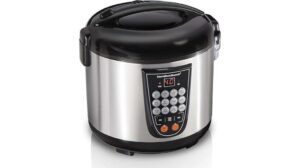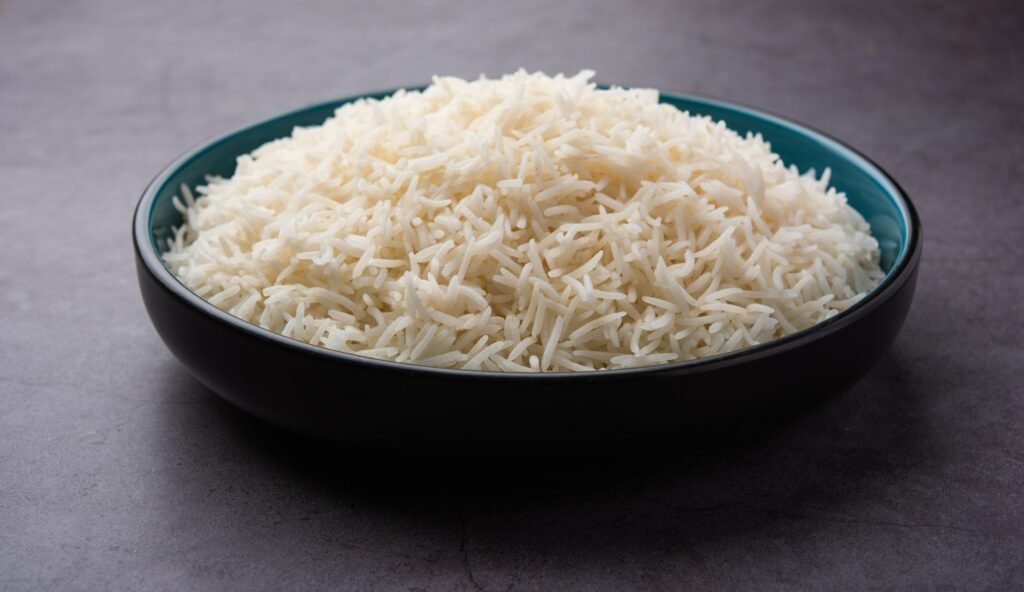
Basmati rice is popular for its distinctive aroma and taste but I have found that it can be one of the trickiest kinds of rice to get right, especially if you’re not if you are not well familiar with it. In the past, I’ve struggled with I found out that simple techniques like soaking, incorrect water ratio, and not adding oil and salt, are the 3 common mistakes people make while cooking basmati rice.
Table of Contents
The Allure of Basmati
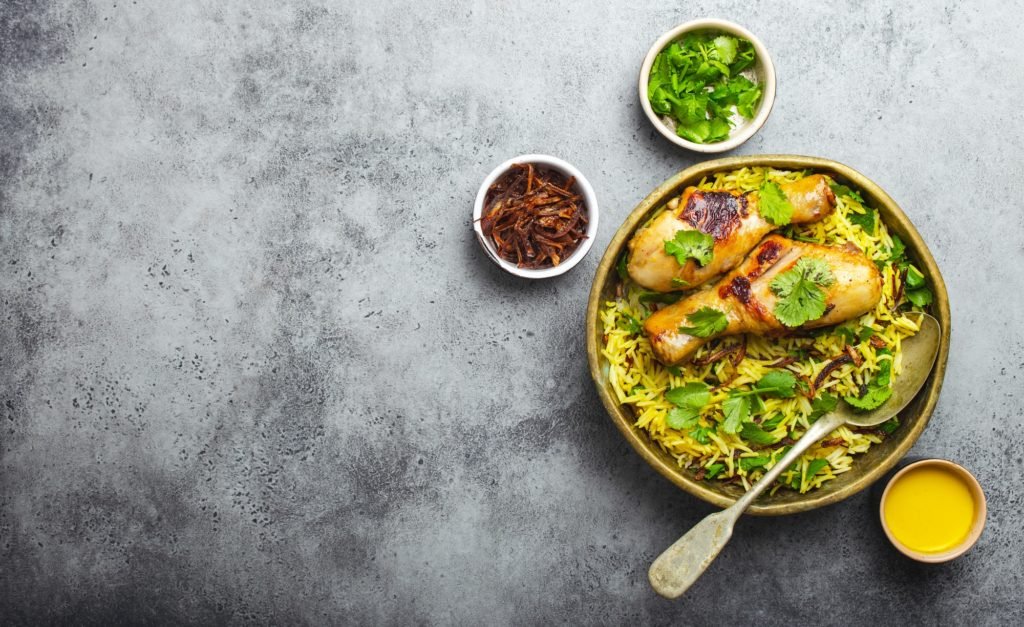
Once you taste perfectly cooked Basmati rice, you may never want to eat any other kind. You see, the taste of basmati rice transports you to the Middle East where spices and herbs, nuts, and aromatics overpower your senses.
It has a unique and distinct set of characteristics that make it truly stand out among the other varieties of rice.
Along with jasmine rice, basmati rice has also captured the attention of some of the world’s greatest chefs because of its distinct fragrance, especially when cooked.
It’s also a very healthy variety and has better nutritional properties than regular white rice because of its increased fiber content.
But, it has a downside – because a lot of people still find it hard to cook perfect basmati rice.
What Makes Basmati Rice Unique?
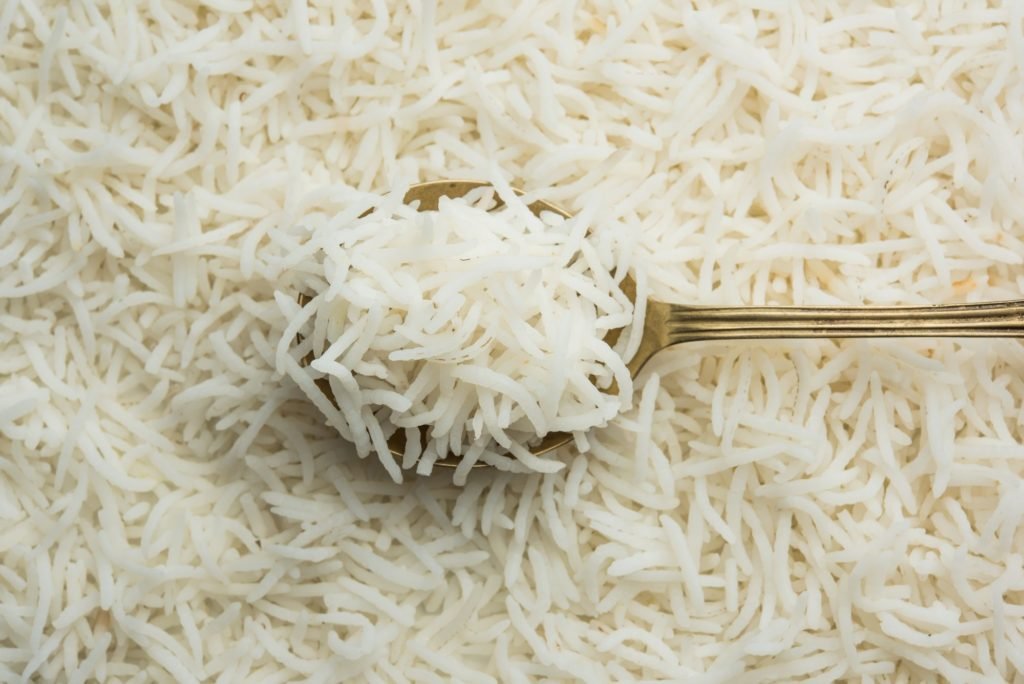
Basmati rice is not only popular because of its aroma but also because of its wonderfully soft and fluffy texture. This is created when you cook it because the grains are separated and they retain water, so they expand.
A lot of people say that jasmine rice and basmati rice have the same aroma, but for me, basmati rice has a more distinct and stronger scent.
Another unique characteristic of basmati rice is that, as gets older, it releases a stronger aroma, which is why most premium brands are at least 2 years old before they hit the shelves.
So, it is good. But how do you cook it to perfection? Well, before I discuss the perfect way to cook basmati rice, let’s take a look at what can go wrong. These are my three most common mistakes when cooking basmati rice. Make sure you don’t make any of them!
3 Common Mistakes People Make While Cooking Basmati Rice
Despite what a lot of people think, cooking homemade basmati rice doesn’t have to be complicated, as long as you understand the basic techniques required to get good results. What you want to do, is achieve those long, separated, and fluffy grains that make this grain unique apart from its aroma.
Find out how to cook the perfect basmati rice by avoiding these 3 common mistakes:
1.0 Not Soaking The Rice

For most varieties of rice, you must wash and rinse them. However, when it comes to basmati rice, the most important part of the prep is to make sure you soak the grains.
Most of my basmati rice disasters have happened because I missed out on this important step, so make sure you don’t do the same!
And it seems I’m not alone because, time after time, when I discuss this with my friends, they tell me the same thing. Things got so bad for a while that I researched the problem and discovered that most Middle Eastern recipes recommend that you soak basmati grains, as this helps them to expand and also shortens the cooking time.
As well as the benefits listed above, soaking also retains most of the flavor and texture of the grain, making sure you get the most out of the rice. So, just to recap, here’s how I prepare my basmati rice.
- I measure the amount that I need in a large bowl.
- Place the bowl under cold running water and rinse at least 3 times.
- After rinsing, add more water, just enough to cover the grains. Soak for about 30 minutes. The longer time you soak, the lesser cooking time you’ll need.
- Drain the water after 30 minutes and cook the rice.
2.0 Not Using The Correct Water Ratio

Again and again, you always read that water plays an important role in cooking different types of rice. In most cases, the only thing that differs is the amount of water you need to use.
For white rice, the general rule is 1:1 rice to water. However, the water ratio should be increased based on the size and hardness of the grains.
If you notice, colored grains such as brown rice, red, black, and wild rice need more water than any other varieties. Basmati rice, on the other hand, needs a little more—in fact, about a half cup more.
Basmati rice is different from other East Asian rice varieties because it has less starch. Because the amount of starch in a grain of rice determines how much water it can absorb, lower starch varieties such as Basmati, as you can probably work out, need less water.
So if you are cooking one cup of basmati rice, you only need to add 1 & 1/2 cups of water. For larger batches of basmati rice, you only need to add that extra half cup so, for 2 cups of rice, just add 2& 1/2 cups of water, and so on.
3.0 Not Seasoning the Rice
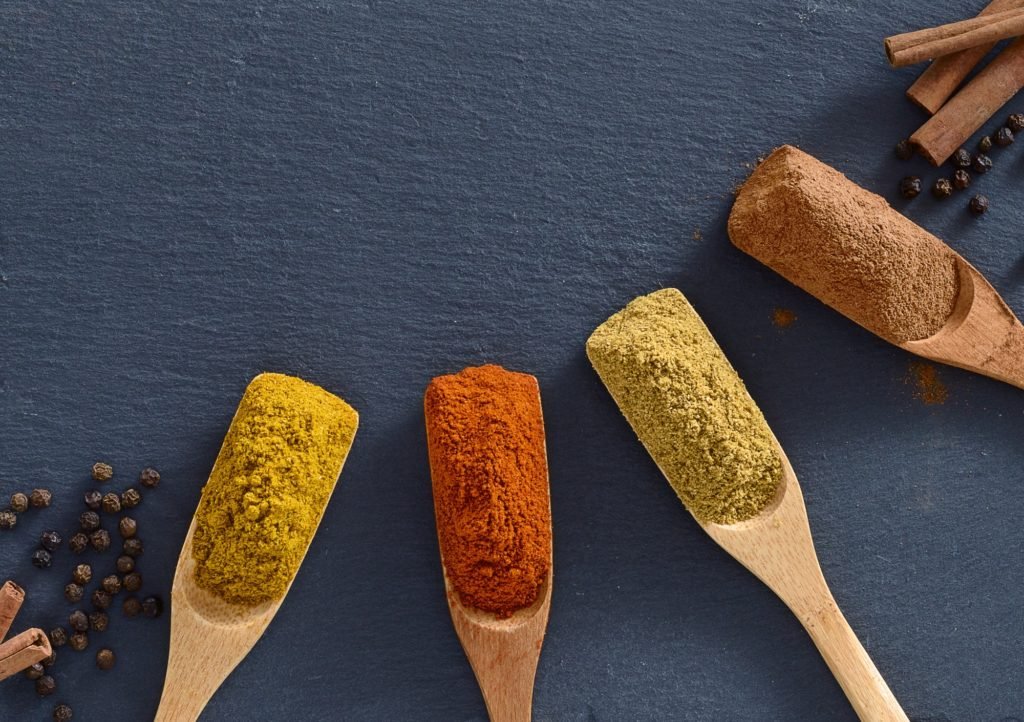
Although homemade basmati rice does not need anything added to it, like most other foods, it really benefits from adding some simple seasoning – such as salt, for example.
Oil helps to lock in the water and avoid any spill-overs, while salt releases the fragrant aroma when cooking as well as adding extra flavor to your rice.
If you go to restaurants, you will notice that their basmati rice tastes better but why do you think that is?
Well, these two simple ingredients are actually their not-so-secret weapons.
Seasoning basmati rice also makes it ready for the many different rice dishes you may want to eat it with.
- After adding the correct amount of water to your basmati rice, add a pinch of salt and a splash of oil to seal in the flavor and aroma.
- For authentic Indian-style or Middle Eastern basmati recipes, you can substitute ghee instead of regular oil.
Apart from these 3 common mistakes, one thing that many cooks overlook is actually the choice of basmati rice itself.
Basmati rice comes from Asia and the Middle East and, honestly, if you want the very best results then you should only buy brands that come from these parts of the world.
I usually use Tilda, Daawat, and Royal brands because they all have great quality basmati grains. You can also buy them online so you can read consumer reviews before buying.
All these brands mentioned have soft, separate, fluffy grains, perfect for a bowl of restaurant-style basmati rice.
How to Make Yellow Basmati Rice
I’ve enjoyed eating java rice, a traditional variation of yellow rice that includes turmeric, for almost as long as I can remember. It originated in Southeast Asia and has a very unique taste and aroma. Many people also swear that it has amazing health benefits but, then again, rice is generally a very healthy dish in any case.
But, did you know that Basmati rice can turn yellow as well? Just like java rice, you can add turmeric to achieve a golden color, but if you want to push the boat out then you can use saffron. This is a lot more expensive (saffron is one of the most expensive spices you can buy and an ounce of it costs more than an ounce of gold), but it gives the rice a beautiful aromatic flavor and if you are lucky enough to visit the Middle East, you will see saffron rice in almost every top restaurant.
How to Add Saffron to Basmati Rice
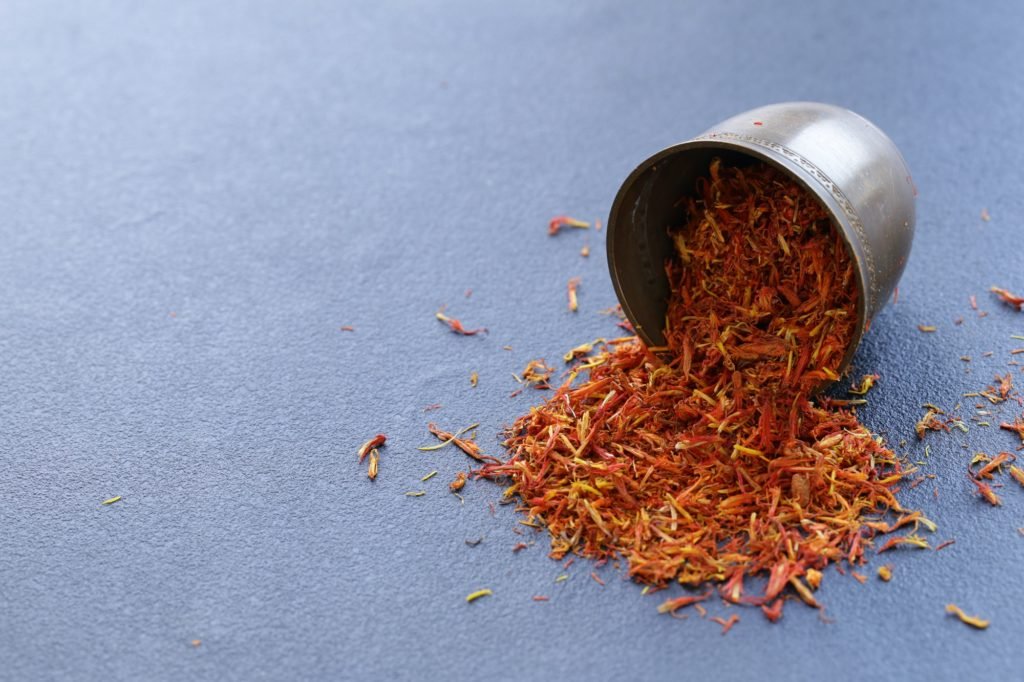
- Warm at least a tablespoon of water or milk (whichever you prefer) in the microwave.
- Pulverize the saffron with your fingers and then add it to the warm liquid.
- Stir for a few seconds and let it sit for about 10-20 minutes. This is perfect when you are cooking basmati rice on the side
- When the rice is cooked, get a quarter cup of cooked basmati and mix with your saffron.
- Add the yellow rice on top of the white and serve!
Adding Turmeric to Basmati Rice
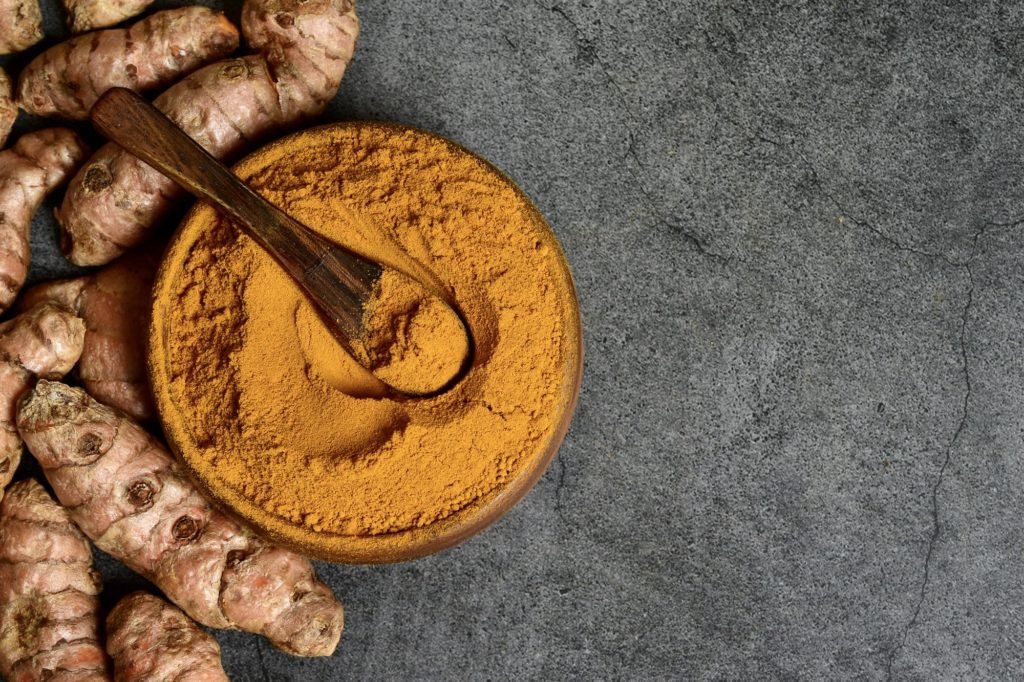
If you don’t want the strong scent of saffron, then turmeric makes a great – and cheaper alternative. It’s also renowned for its rich antioxidant properties.
You can do the same procedure as the saffron, except replace it with turmeric.
- You can use an eighth teaspoon of turmeric and a tablespoon of water.
- Mix 1/4 cup of cooked basmati rice into your mixture.
- Add it back to the white rice and serve
Or, Add Herbs & Spices
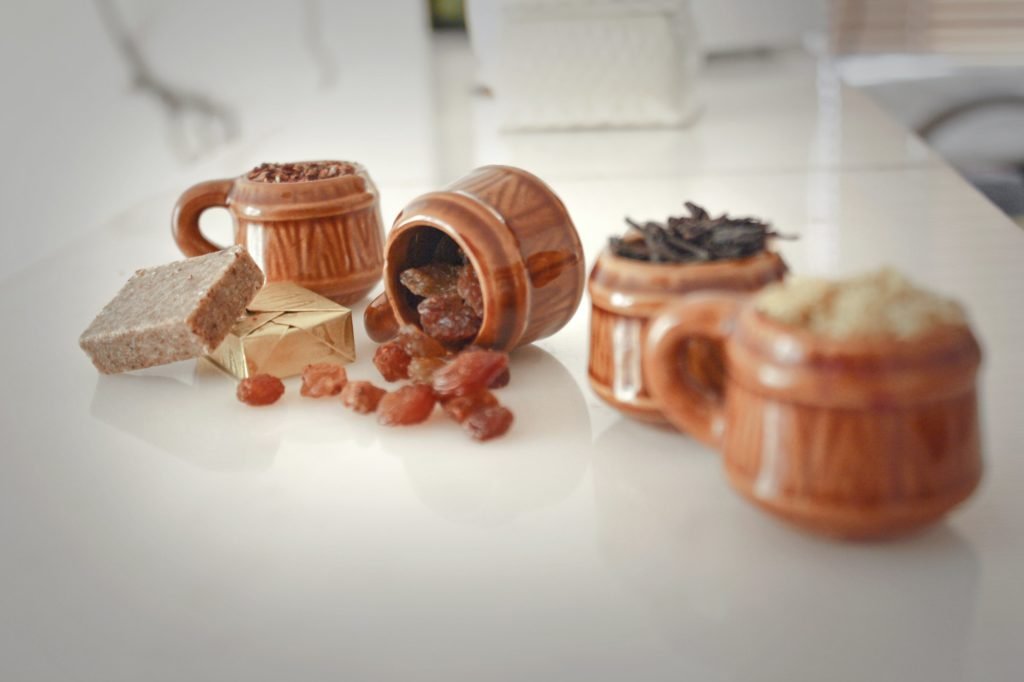
To add a deep, rich flavor to your basmati rice, I recommend that you experiment by adding various herbs and spices. For example, you can try cooking Indian-style basmati.
You can do this by adding spices such as cinnamon, cardamom, bay leaves, and cumin seeds and, of course, if you want a little kick then add some curry powder – just don’t overdo it.
How to Cook Perfect Basmati Rice
For many years, I believed that basmati rice was too difficult to cook – it just seemed so intimidating but, once you uncover some simple secrets like those discussed above, it doesn’t seem so daunting after all.
Just like most other kinds of rice, there are two main cooking methods for making the best basmati, on the stove-top and in your rice cooker. But, for me, basmati is best cooked using a good rice cooker – every time!
However, not everyone has a rice cooker so, first of all, let’s look at how to cook basmati rice on a stove.
How to cook basmati rice using the stovetop
What you will need:
- 1 cup of Basmati rice
- a cup and a half of water
- half teaspoon salt
- 1 tablespoon of butter (unsalted)
- Optional ingredients: cardamom, saffron, and other spices
How to Cook:
- After you have soaked the basmati rice, gently drain all the water using a colander until all the water is out
- Add the rice and 1 & 1/2 cups of water into a medium-sized saucepan together with the salt, butter, and the optional ingredients if you prefer
- Cover the pan with a tight-fitting lid and bring it to a boil. Cook for about 20 minutes or until all water is absorbed and the rice is tender
- If the rice comes out a little firm, add at least 2 tablespoons of water and continue cooking. But, if the rice is already tender, turn the heat to its lowest and leave it steaming for at least 5 minutes.
- When the rice is cooked, gently fluff it with a fork and turn the heat off. Let it rest for another 5 minutes.
- Serve!
How to cook basmati rice using a rice cooker
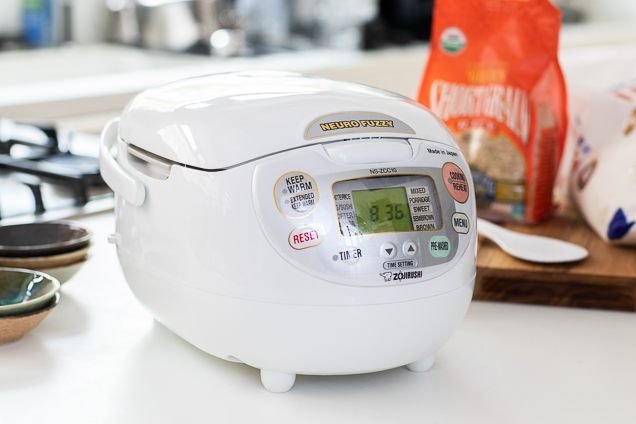
As you probably know, I’m a big fan of rice cookers, not only because you can get great results from them but also because they are just so convenient.
When it comes to Basmati rice, even though it’s one of the trickiest to get right, it’s still possible to get amazing results using even basic machines. However, for the very best results, you really should use a cooker that has neuro-fuzzy logic technology that allows your cooker to ‘act and think’ on its own and make temperature and time adjustments in order to achieve the perfect outcome.
One of the best rice cookers I’ve come across is the Zojirushi NS-ZCC10. It is a neuro-fuzzy rice cooker and warmer that cooks flawless rice. This rice cooker features a variety of cooking settings from regular white rice, and basmati to jasmine, brown rice, and even instant rice.
Here is how to cook Basmati Rice using the amazing Zojirushi NS-ZCC10:
- Place the drained rice in the rice cooker’s inner pot and add 2 cups of water. Note: You must use the measuring cup included in the box.
- Select the Regular White Rice setting on the cooking menu, and leave the cooker to do its thing!
- When the device beeps, informing you that your rice is cooked, gently fluff it with a spatula and let it Keep warm for a few minutes.
- Serve warm!
How simple is that? No watching a pot, no stirring or fiddling around. Because of the fuzzy logic, the cooker literally does all of the hard work. Now that’s a technology I can buy into.
How to Make Basmati Rice Sticky
Making basmati rice sticky requires more than just proper cooking techniques.
To get the perfect sticky texture, you should start by choosing the right type of basmati rice. Look for Indian Basmati or Pakistani Basmati — these are typically aged kinds of rice with optimal stickiness. However, even aged basmati can dry out if cooked improperly.
To prevent this, begin by rinsing the rice several times before boiling it in salted water which is four parts water to one part rice.
To prevent the rice from sticking together after it’s cooked, add a few drops of oil or butter while boiling. Once the rice is boiled, lower the heat, cover it with a tight lid, and leave it to steam for ten minutes more before serving; this will help it maintain adequate moisture so that the grains remain separate yet remain nice and sticky.
When the rice’s texture starts to soften and become sticky, reduce the heat to low and cover it for about ten minutes until fully cooked. Keeping a close eye on it will ensure your basmati rice comes out perfectly sticky every time.
Summary
Making rice is simple, but making great rice isn’t. Because every variant has its own characteristics and cooking techniques, it’s not always as easy as you might think to get top-quality results.
However, even when it comes to notoriously difficult varieties such as basmati rice if you avoid the common mistakes – and I shared 3 of them here – then it’s not only possible, but it’s actually probable that you will get results that even professional chefs would be proud of.
Just remember that soaking, adding the correct water ratio, and seasoning the rice are the keys to achieving a great-tasting bowl of basmati rice. Then, when you understand the cooking process you are almost guaranteed to get great results – especially if you make use of today’s best rice cooker technology.
And that’s where the Zojirushi NS-ZCC10 comes in. Its modern neuro-fuzzy technology is superb and reduced the problem of cooking basmati rice to, quite literally, the push of a button. If you are pressed for time or don’t enjoy the manual labor of cooking, then it really is a great investment!
So, I hope you have learned something and have enjoyed reading this short article. It’s over to you now – go and enjoy some fantastic basmati rice dishes – cooked to perfection, of course!
Have you tried cooking basmati rice? Let me know your cooking tips in the comments below!
Hopefully, you enjoyed this post and, if you would like to find out more great ways to use your rice cooker, I have posts covering how to cook pasta, fish, or even lentils. Who knew that a rice cooker could be so versatile ?!




